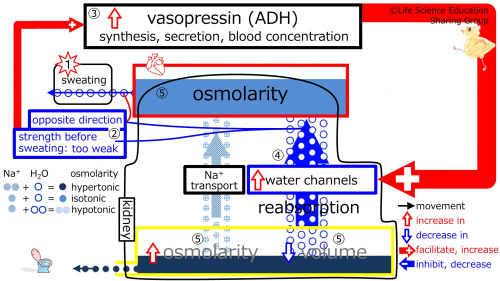SHolroydAtWeilCornellMedQatar/Endocrinology/VasopressinADH/ControlToSweating
| Sweating will increase plasma osmolarity. This will in turn lead to a increase in the synthesis, secretion and blood concentration of ADH. |
video prior to sweating
Prior to sweating we assume our subject is in homeostasis with normal plasma and urine osmolarities and volumes.
video just after sweating
Steps 1 and 2: The subject sweated. Water will leave the plasma and its osmolarity will increase. Sweating will increase, and the ADH/water channels/reabsorption of water by the kidney will decrease plasma osmolarity, having the opposite effect. Thus, in this case with high plasma osmolarity, the effect of ADH/water channels/reabsorption would be too little.
video just after ADH increased responding to sweating
Steps 3 and 4: With too little effect of ADH/water channels/reabsorption, the negative feedback increases (the synthesis, secretion, and blood concentration of) ADH. The ADH-facilitating effect on the water channels will increase, increasing the number of water channels. This increases the reabsorption of water by the kidney.
video showing the changes in plasma and urine after ADH increased responding to sweating
Step 5: The ratio of Na+ to water reabsorption by the kidney decreases. This means plasma osmolarity decreases. The increased plasma osmolarity from sweating will decrease returning to normal.
Because a lower ratio of Na+ is reabsorbed the fluid left in the tubule now has a higher osmolarity. The increase in the number of water channels increases water reabsorption so there is less water. So overall the urine becomes more concentrated and low volume.
Challenge Quiz
<GIFT> //LEVEL:2 //RAND The negative feedback response to an increased sweating is a(n) {~=increase~decrease} of ADH secretion.
//LEVEL:3 //RAND The negative feedback response to an increased sweating is a(n) {~=increase~decrease} of water channels in the kidney.
//LEVEL:2 //RAND The negative feedback response to an increased sweating is a(n) {~=increase~decrease} in water reabsorption by the nephron.
//LEVEL:3 //RAND The negative feedback response to an increased sweating is a(n) {increase~=decrease} in urine volume.
//LEVEL:3 //RAND The negative feedback response to an increased sweating is a(n) {~=increase~decrease} of urine osmolarity.
//LEVEL:3 //RAND The negative feedback reaction to an increased sweating is a(n) {increase~=decrease} of plasma osmolarity.
//LEVEL:3 //RAND When you sweat the plasma osmolarity {decreases~=increases}. This has the effect of {~=increasing~decreasing} the release ADH. This in turn {~=increases~decreases} the number of water channels by the nephron causing {~=increased~decreased} water reabsorption. Urine osmolarity will {~=increase~decrease} while volume will {increase~=decrease}. This will {~=decreasing~increasing} plasma osmolarity {~=returning to normal~separating from normal}.



